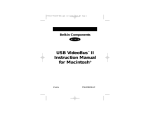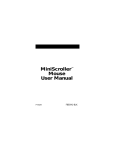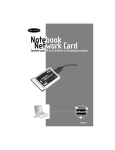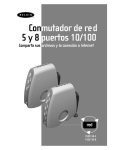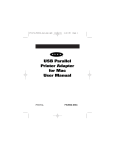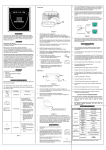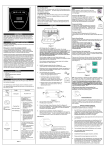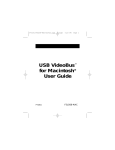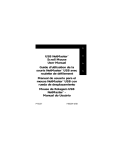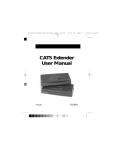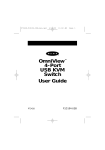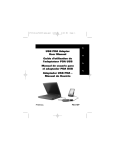Download Belkin Classic F8E201-BLK User's Manual
Transcript
P73096-F8E201-US-man-qxd 3/9/00 8:14 AM Page 1 ClassicMouse User Manual P73096 F8E201 F8E201-BLK P73096-F8E201-US-man-qxd 3/9/00 8:14 AM Page 2 P73096-F8E201-US-man-qxd 3/9/00 8:14 AM Page 1 1. Introduction ABOUT YOUR MOUSE 1.1 An Introduction to Your New Belkin ClassicMouse The Belkin ClassicMouse is a high-resolution three-button mouse designed for today’s active PC user. It works with Microsoft® systems for optimum compatibility, and its sleek design helps reduce stress and undue hand and wrist fatigue. It features dynamic resolution, low-friction rollers and three separate function micro-switch buttons for years of productive use. Once the software has been loaded onto your computer, the center button of your mouse can be programmed to perform the same tasks as: • • • • • • • Left Button Double Click F1 through F12 Enter Key Page Up Key Page Down Key Home Key End Key 1 P73096-F8E201-US-man-qxd 3/9/00 1. Introduction 8:14 AM Page 2 (continued) 1.2 Connecting Your Mouse Your mouse connects to either a PS/2 (or 6 pin MiniDIN) mouse port or a 9 pin serial port. To verify your connectors, locate the port on the back of your computer that is designated for your mouse. Most PCs will have the word MOUSE marked next to the PS/2 connector. Older PCs will have either Serial 1 (and up) or COM 1 (and up) for the serial connector. If you are still unsure, please refer to your hardware manual. 9 pin Serial 6 pin MiniDIN For PS/2 mouse port installation, simply remove the serial adapter before connecting the mouse cable to the computer. WARNING: To avoid damage, turn your computer off before plugging or unplugging any pointing devices. a. Locate the computer PS/2 mouse port or Serial port on the back of your computer. b. Plug your mouse into the appropriate port suggested above. Check the box in which your mouse was shipped to verify the ports supported. c. If applicable, tighten down the connector thumbscrews. d. Turn your computer on. At this point, your mouse will work with the built-in Microsoft® Operating System. To use the extra features of your middle button, you must install the included software. 2 P73096-F8E201-US-man-qxd 3/9/00 8:14 AM Page 3 2. Software Installation A STEP BY STEP GUIDE 2.1 Windows® 3.1 and Windows® 3.11 a. Insert the ClassicMouse diskette in the A: or B: drive. b. From the “Program Manager”, click on “File”, then click on “Run”. c. Type “A:setup” or “B:setup” and then click on “OK”. d. Follow the on-screen instructions to complete the installation of the ClassicMouse. e. To make the process run smoothly: 1. Click “Next” twice. 2. Type your name and the company’s name, then click “Next”. 3. Click “Next” twice. 4. Specify if you are using a PS/2 or Serial mouse (refer to section 1.2) then click “OK”. 5. Select “Yes, I want to restart my computer now” then click on “Finish”. Note: Remove the software from the disk drive before you restart your computer. Don’t worry if it has already restarted before you can remove it. The computer will prompt you to remove it. 3 P73096-F8E201-US-man-qxd 3/9/00 8:14 AM 2. Software Installation Page 4 (continued) 2.2 Windows® 95, Windows® 98 and Windows NT® 4.0 a. Insert the ClassicMouse™ diskette in the A: or B: drive. b. Click on "Start" in the lower left corner of your screen, then click on "Run". c. Type "A:setup" (or "B:setup") and then click on "OK". d. Follow the on-screen instructions to complete the installation of the ClassicMouse™. e. To make the process run smoothly: 1. 2. 3. 4. 5. Note: Click on “Next” twice. Type your name and the company’s name, then click “Next”. Click “Next” twice. Specify if you are using a PS/2 or Serial mouse (refer to section 1.2) then click “OK”. Select “Yes, I want to restart my computer now”, then click “Finish”. Remove the software from the disk drive before you restart your computer. Don't worry if it has already restarted before you can remove it. The computer will prompt you to remove it. 4 P73096-F8E201-US-man-qxd 3/9/00 8:14 AM Page 5 3. Troubleshooting Q: A: Q: A: Q: A: When installing the software, which driver should I choose? The PS/2, Serial Mouse on COM1, or Serial Mouse on COM2? If you are using a PS/2 mouse (refer to section 1.2), then the driver must state that it is using a PS/2 driver. If you are using a Serial mouse (refer to section 1.2), then the driver must state that it is using a Serial driver on COM1 or COM2. I can get into Windows® or into Safe Mode but I cannot use the mouse. If you have more than one driver, this could be causing your computer to boot in safe mode or not allow your mouse to work at all. If you are using a PS/2 mouse then the driver must state that it is using a PS/2 driver. If you are using a Serial mouse then the driver must state that it is using a Serial driver on COM1 or COM2. If you have a Serial Mouse and you are not sure whether you are using COM1 or COM2 then try moving the mouse to another serial port on the back of your computer (most computers have two; if you have only one then it will more than likely be COM1). If you have more than one driver then you must remove the excess drivers. If I have more than one mouse driver how do I remove the driver without the mouse control? How do I boot into normal Windows® mode? Use your "Windows®" key at the bottom left hand corner of your keyboard if you have one; if not, press "Alt + S" to go to the "Start" button in Windows® 98. Then use your “Up” arrow" to select "Settings", then use your “Right” arrow to select "Control Panel" and then press "Enter". 5 P73096-F8E201-US-man-qxd 3/9/00 8:14 AM 3. Troubleshooting Page 6 (continued) These steps have taken you to the "Control Panel" where you can gain access to your "Device Manager". The "Device Manager" shows your driver status and information and it will allow you to modify their settings. After entering the "Control Panel" use your "Up" and "Down" arrows to select "System", and then press "Enter". After entering "System Properties" use your "Right” arrow to select "Device Manager". Then press "Tab" until you have selected "Computer" and then use the "Down” arrow until your "Mouse" is highlighted. Then use your "Right” arrow to expand and select your mouse driver or drivers. After you have chosen your mouse driver you can now modify it by removing the driver or changing the driver. To remove the driver you have selected, use your "Tab" key until the "Remove" tab is selected. Then press "Enter". This will remove the driver. Use your "Arrow” keys to select any other drivers and repeat the process until all but one driver remains. Even if it is the wrong driver you can use it and change it to the mouse driver you want. After removing or changing the mouse driver, use your "Tab" key until "Close" is selected and then press "Enter". Then you will have to reboot your computer. Use your "Windows®" key at the bottom left hand corner of your keyboard if you have one; if not, press "Alt + S". Then use the "Up” arrow to select "Shut Down" and press "Enter". Use your "Arrow” key to select "Restart" and press "Enter". Q: After installing the mouse driver and rebooting, my mouse will not work. How do I change the mouse driver without mouse control? 6 P73096-F8E201-US-man-qxd 3/9/00 8:14 AM 3. Troubleshooting A: Page 7 (continued) Use your "Windows®" key at the bottom left hand corner of your keyboard if you have one; if not press "Alt + S" to go to the "Start" button in Windows® 98. Then use your "Up" arrow to select "Settings" then use your "Right" arrow to select "Control Panel" and then press "Enter". These steps have taken you to the "Control Panel" where you can gain access to your "Device Manager". The "Device Manager" shows your driver status and information and it will allow you to modify their settings. After entering the "Control Panel" use the "Up" and "Down" arrows to select "System" and then press "Enter". After entering "System Properties" use the "Right" arrow to select "Device Manager". Then press "Tab" to bring your selection to "Computer" and then use the "Down" arrow until your "Mouse" is highlighted. Then use your "Right" arrow to expand and select your mouse driver or drivers. After you select the mouse driver, use your "Tab" key to select "Properties" and then press "Enter". Use your "Right” arrow key to choose the "Driver" tab and then use your "Tab" key to choose "Update driver" and then press "Enter". The next options will vary from computer to computer because there are many types of Windows® operating systems. The wording or options will be a little different but should be somewhat the same. Windows® will then continue to ask questions and help guide you through the changes. Use your "Arrow" keys, "Enter", and "Tab" keys to continue through the process. Windows® may or may not start searching for Plug-andPlay devices right away, and it may or may not find 7 P73096-F8E201-US-man-qxd 3/9/00 8:14 AM 3. Troubleshooting Page 8 (continued) anything new. If it does not find anything new it will ask you another line of questions, and if it does find something new choose something similar to "This Device is not in the list". Windows® will then ask if you want Windows® to search for a new device or will ask if you want to select a driver from a list. You will want to choose a device or driver from a list. Use your "Arrow", "Tab" and "Enter" keys to navigate and finish until the end of questioning. After finishing, Windows® may or may not ask you to reboot your computer. You will want to restart your computer. If it does not ask you to restart your computer you will have to close "System Properties". Use the "Tab" key until "Close" is selected and then press "Enter". You will have to restart your computer. Use your "Windows®" key at the bottom left hand corner of your keyboard if you have one; if not, press "Alt + S". Then use the "Up” arrow to select "Shut Down" and use your "Enter" key. Use the "Arrow" key to select "Restart" and press "Enter". Q: Why does my external mouse not work with my laptop computer? A: You may have to disable the onboard mouse in order to use an external mouse. Try looking in your CMOS or BIOS in order to disable the onboard mouse. If you do not have this option or do not know how to get into your BIOS or CMOS, please follow instructions in your computer manual or call the computer dealer or technical support for your computer. 8 P73096-F8E201-US-man-qxd 3/9/00 8:14 AM 3. Troubleshooting Page 9 (continued) Q: A: My mouse works but the middle button will not work. Look at the bottom of the mouse; it will have a switch labeled PC/MS. Try moving it to the PC mode and then restart. Also, go to “Start”, select “Programs” and look for the mouse folder. There will be a program in this folder to program the middle button. Q: Why does the mouse pointer act irregularly on the screen? Look at the bottom of the mouse; it will have a switch labeled PC/MS. Try moving it to the opposite direction and then restart. A: 9 P73096-F8E201-US-man-qxd 3/9/00 8:14 AM Page 10 4. How to Use Your ClassicMouse 4.1 Changing Mouse Settings To program your middle button, click the “Mouse Control Panel” from the taskbar. To test if your mouse is responding properly, keep the pointer anywhere in the window and click either the left, middle or right button. The button on the picture of the mouse (top middle of window) will light up for the corresponding button. Program your middle button to perform your most frequently used tasks by clicking on any portion of the box with the word “Unassigned” in it. Highlight the feature you would like your middle button to perform. Once you select “OK”, your middle button will be programmed. To change the command, simply repeat the process above. “Double Click Speed” allows you to modify the speed at which your mouse responds. The slower the setting, the slower you can double click for your mouse to respond. To see which speed is best for you, try double clicking within the “Test” box. If you double click and it does not change color, you might want to change the speed to a lower setting. “Mouse Speed” determines how quickly your pointer moves across the screen. The faster the setting, the higher the response. The slower the setting, the lower the response. Directly below the “Mouse Speed” is a small box marked “Swap Left/Right” button. This feature is mainly for left-handed users. By clicking on the box, the right and left button functionality are switched. To switch it back, simply click in the box again (using the right button – remember, they’re switched!). • • • To keep your setting(s), select “OK”. To keep your settings as they were before you opened the settings window, select “Cancel”. To return the settings to the Belkin default, click on “Reset”. 10 P73096-F8E201-US-man-qxd 3/9/00 8:14 AM Page 11 4. How to Use Your ClassicMouse (continued) 4.2 Care for Your Mouse Maintenance of your ClassicMouse is important. It is designed to provide years of trouble-free service. A self-cleaning ball cage helps prevent dust and lint from building up around the ball. However, if the pointer should skip or move abnormally on screen, we recommend you clean your mouse manually. a. First, turn the retainer ring counterclockwise to remove the ball. b. Wipe the ball with a clean lint-free cloth. c. Blow into the ball cage to dislodge any dust and lint. d. If there is build-up on the rubber rollers inside the ball cage, clean using a cotton swab lightly coated with isopropyl alcohol to remove any debris. 11 P73096-F8E201-US-man-qxd 3/9/00 8:14 AM Page 12 5. Uninstall REMOVING THE MOUSE SOFTWARE FROM YOUR COMPUTER WARNING: To avoid damage, turn your computer off before plugging or unplugging any pointing devices. 5.1 Windows® 3.1 and Windows® 3.11 a. Double click on the “Windows® Setup” icon in the “Main Group”. b. Select “Options”. c. Select “Change System Setting …” in Windows® 3.1. d. Select “Mouse:\”. e. Choose the new mouse driver you require. This will override any previous settings. f. If you are prompted to keep current driver, click on “Current”. 5.2 Windows® 95, Windows® 98 and Windows NT® 4.0 a. First, it will be necessary to close the “Mouse Control Panel” in your taskbar. Click on the "X" button in the upper right corner of the “Mouse Control Panel” window. When asked if you are sure if you want to quit, click on "Yes". Now you are ready to begin the uninstall process. b. Select “Start”, point to “Settings” and click “Control Panel”. c. Double click on “Add/Remove Programs”. d. In the “Install/Uninstall” window, you will be asked if you are sure if you want to remove "Belkin Mouse Driver" and all of its components. Click “Yes”. e. The uninstall process will begin. Follow the on-screen instructions to complete the process. 12 P73096-F8E201-US-man-qxd 3/9/00 8:14 AM Page 13 Information FCC Statement DECLARATION OF CONFORMITY WITH FCC RULES FOR ELECTROMAGNETIC COMPATIBILITY We, Belkin Components, of 501 West Walnut Street, Compton CA 90220, declare under our sole responsibility that the product: F8E201/F8E201-BLK to which this declaration relates: Complies with Part 15 of the FCC Rules. Operation is subject to the following two conditions: (1) this device may not cause harmful interference, and (2) this device must accept any interference received, including interference that may cause undesired operation. CE Declaration of Conformity We, Belkin Components, declare under our sole responsibility that the F8E201/F8E201-BLK, to which this declaration relates, is in conformity with Generic Emissions Standard EN500811 and with Generic Immunity Standard EN50082-1 1992. Belkin Components Limited Lifetime Product Warranty Belkin Components warrants this product against defects in materials and workmanship for its lifetime. If a defect is discovered, Belkin will, at its option, repair or replace the product at no charge provided it is returned during the warranty period, with transportation charges prepaid, to the authorized Belkin dealer from whom you purchased the product. Proof of purchase may be required. This warranty does not apply if the product has been damaged by accident, abuse, misuse, or misapplication; if the product has been modified without the written permission of Belkin; or if any Belkin serial number has been removed or defaced. THE WARRANTY AND REMEDIES SET FORTH ABOVE ARE EXCLUSIVE IN LIEU OF ALL OTHERS, WHETHER ORAL OR WRITTEN, EXPRESSED OR IMPLIED. BELKIN SPECIFICALLY DISCLAIMS ANY AND ALL IMPLIED WARRANTIES, INCLUDING, WITHOUT LIMITATION, WARRANTIES OF MERCHANTABILITY AND FITNESS FOR A PARTICULAR PURPOSE. No Belkin dealer, agent, or employee is authorized to make any modification, extension, or addition to this warranty. BELKIN IS NOT RESPONSIBLE FOR SPECIAL, INCIDENTAL, OR CONSEQUENTIAL DAMAGES RESULTING FROM ANY BREACH OF WARRANTY, OR UNDER ANY OTHER LEGAL THEORY, INCLUDING BUT NOT LIMITED TO LOST PROFITS, DOWNTIME, GOODWILL, DAMAGE TO OR REPROGRAMMING, OR REPRODUCING ANY PROGRAM OR DATA STORED IN OR USED WITH BELKIN PRODUCTS. Some states do not allow the exclusion or limitation of incidental or consequential damages or exclusions of implied warranties, so the above limitations of exclusions may not apply to you. This warranty gives you specific legal rights, and you may also have other rights that vary from state to state. P73096-F8E201-US-man-qxd 3/9/00 8:14 AM Page 14 belkin.com Belkin Components 501 West Walnut Street Compton • CA • 90220 • USA Tel: 310.898.1100 Fax: 310.898.1111 Belkin Components, Ltd. Unit 13 • Gatelodge Close • Round Spinney Northampton • Northants • NN3 8RX • United Kingdom Tel: +44 (0) 1604678300 Fax: +44 (0) 1604678330 Belkin Components B.V. Diamantlaan 8 • 2132 WV Hoofddorp • The Netherlands Tel: +31 (0) 235698765 Fax: +31 (0) 235612694 © 2000 Belkin Components. All rights reserved. All trade names are registered trademarks of respective manufacturers listed.
















